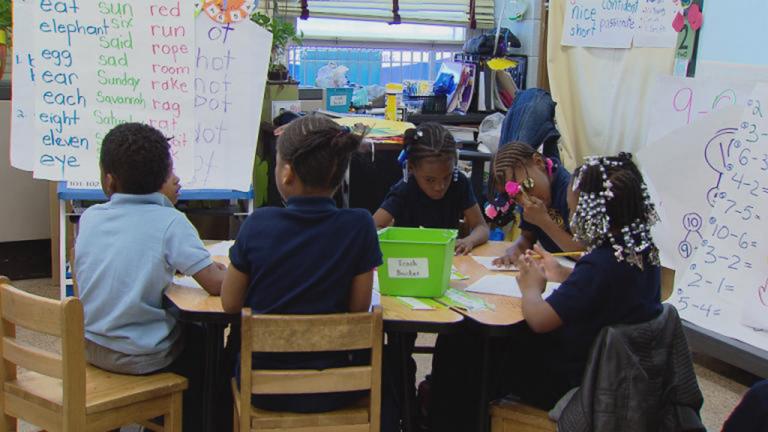Karen Moore is celebrating her 25th year as an educator. She’s a special education teacher in Harvey, Illinois. She says the pandemic has magnified issues that existed before COVID-19, including the teacher shortage Illinois and other states across the country are facing.
“One of the biggest challenges we face is the simple fact of who cares? We really wanna know who cares. The teachers are boots on the ground, in the classroom with our students, and then so much is being piled onto us,” Moore said.
In addition to a teacher shortage, there is a substitute teacher shortage too, Moore said. When absences aren’t covered, some staff members and teachers are asked to fill in where needed, which adds another layer of stress, she said.
Moore said that in addition to the shortage overall, there is especially a shortage of teachers of color.
“There is a definite need for teachers of color in these high poverty areas where we have students of colors there’s not enough teachers that look like the students and we are definitely seeing a lack of the male presence in the teaching profession,” Moore said
A new survey among Illinois school leaders show the state’s superintendents fear the teacher shortage is getting worse. And educators in the state say the pandemic — especially the omicron variant — poses an added challenge to keeping schools open and staffed.
Eighty-eight percent of superintendents surveyed in the state report a teacher shortage problem. Meanwhile, 96% of school districts surveyed believed they have a substitute teacher shortage problem. The survey was conducted in fall 2021 — before the highly contagious omicron variant arrived.
“We started calling this crisis back in ‘17, when we started our first formal studies. So ‘17, ‘18, and ‘19, we saw it as a crisis. And now I’m starting to say that the crisis has become a cliff,” said Mark Klaisner, president of the Illinois Association of Regional Superintendents of Schools.
The IARSS conducted the survey, in partnership with Goshen Education Consulting. Seventy-seven percent of districts responded to this year’s survey.
Respondents reported a total of 2,040 open positions in the state.
Kathi Griffin was not surprised to see the results of the survey. She’s president of the Illinois Education Association , a union representing educators outside of the city of Chicago.
“That’s what we are seeing in our schools. We did have a teacher shortage before the pandemic and since the pandemic that has only gotten worse, unfortunately,” Griffin said.
In recent months, teachers have had to cover classrooms or lunch duty because there aren’t enough substitutes to fill in, losing planning periods and taking breaks throughout the day.
“There’s so much pressure to make sure you are meeting the needs of students. Know they are dealing with a lot of trauma, as all of us are,” Griffin said. “Teachers are just trying to help students with emotional learning as well.”
Marge Zielinski is a school nurse in the northwest suburbs. She said the first semester this year was rough.
“It was the constant changes in guidance from you know the powers that be. How the information was being dispersed to the nurses. The parents’ understanding of it … and just the sheer volume of the kids that we were seeing. It was just super frustrating … But, you know, we worked through that,” Zieinski said.
At staff meetings, Zieinski tries to motivate others at the school to keep going.
“We have to outsmart this virus. We’re smarter. We’re bigger than the virus. We just have to be adaptable and ride this rough tsunami wave that we just went through with the omicron variant, we have to ride it through,” Zieinski said.
Addressing The Shortage
Griffin says a declining number of college students are choosing to study education. Salary is part of the reason for that, Griffin said.
“I know that the state of Illinois put in a $40,000 minimum salary that will be achieved across the state, which I think could help. However, many of them are going to school with peers that selected a different major and are making a lot more than $40,000 to start their career,” Griffin said.
Klaisner said more is expected of teachers each year, which adds to the pressure.
“Every year there’s more curriculum mandates, there are more requirements on our teachers. Our class sizes are going up,” Klaisner said.
He says there are a variety of possible solutions for the shortage — some are short term and others are more long term. He says there needs to be more short-term routes to get a teachers license, and that teachers’ salaries will also need to be addressed.
Both Klaisner and Griffin also mentioned creating opportunities for high school students to receive dual credit in college education courses.
Moore — the teacher in Harvey — said she has had to talk teachers “off the edge” when they have become overwhelmed by the work and the extra duties they have had to take on.
She tells her colleagues to think about their students.
“I know it’s so hard sometimes to come and do our daily jobs, but what keeps me going is looking in the faces of my students because they are looking at us and they’re depending on us,” Moore said.




